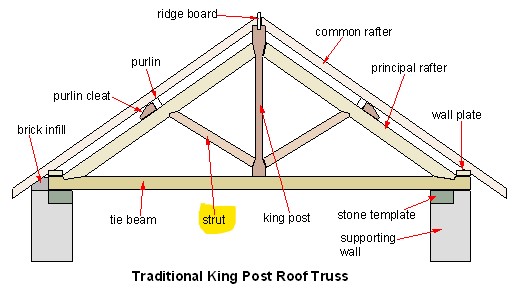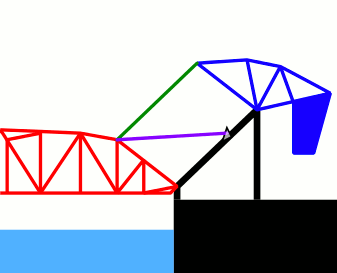Strut

|
Contents |
[edit] Introduction
A strut is a structural component that has compression acting upon it - pushing it together. Struts are most frequently made from timber or metal.
[edit] Struts and ties
The counterpart of a strut is a tie, which is a structural element that has tension acting upon it - stretching it apart. For more information, see Ties.
Struts and ties are common components of structural elements such as trusses. The two components work together to support the weight of other parts of the structure and any imposed load. The struts provide resistance to compression and sometimes contribute to tension resistance. Ties perform the opposite function.
As a component of a moveable bridge, the strut can work in conjunction with other mechanisms to open and close the bridge.
|
This animated GIF depicts the opening and closing of the Henry Ford bridge - a double-leaf bascule bridge built in 1924. For each leaf, the operating strut (in purple) is drawn back using a pinion gear on the fixed structure. This brings the counterweight structure (in blue) down while raising the bridge truss (in red). A parallelogram link (green) means the rotation of the counterweight is synchronised with the rotation of the truss structure. |
[edit] Strutting and strut channels
Strutting is a method of providing temporary support to the side of a trench. It is sometimes called timbering and planking. Strutting can also be used between floor joists to increase the strength of flooring systems. In this instance, it may also be referred to as blocking.
Strut channels (also referred to as channel struts) are components that support cable management and plumbing systems. They are made from steel, aluminium or plastic and can be used to connect pipes, wire, threaded rods or bolts to walls.
[edit] Related articles on Designing Buildings
Featured articles and news
RTPI leader to become new CIOB Chief Executive Officer
Dr Victoria Hills MRTPI, FICE to take over after Caroline Gumble’s departure.
Social and affordable housing, a long term plan for delivery
The “Delivering a Decade of Renewal for Social and Affordable Housing” strategy sets out future path.
A change to adoptive architecture
Effects of global weather warming on architectural detailing, material choice and human interaction.
The proposed publicly owned and backed subsidiary of Homes England, to facilitate new homes.
How big is the problem and what can we do to mitigate the effects?
Overheating guidance and tools for building designers
A number of cool guides to help with the heat.
The UK's Modern Industrial Strategy: A 10 year plan
Previous consultation criticism, current key elements and general support with some persisting reservations.
Building Safety Regulator reforms
New roles, new staff and a new fast track service pave the way for a single construction regulator.
Architectural Technologist CPDs and Communications
CIAT CPD… and how you can do it!
Cooling centres and cool spaces
Managing extreme heat in cities by directing the public to places for heat stress relief and water sources.
Winter gardens: A brief history and warm variations
Extending the season with glass in different forms and terms.
Restoring Great Yarmouth's Winter Gardens
Transforming one of the least sustainable constructions imaginable.
Construction Skills Mission Board launch sector drive
Newly formed government and industry collaboration set strategy for recruiting an additional 100,000 construction workers a year.
New Architects Code comes into effect in September 2025
ARB Architects Code of Conduct and Practice available with ongoing consultation regarding guidance.
Welsh Skills Body (Medr) launches ambitious plan
The new skills body brings together funding and regulation of tertiary education and research for the devolved nation.
Paul Gandy FCIOB announced as next CIOB President
Former Tilbury Douglas CEO takes helm.
UK Infrastructure: A 10 Year Strategy. In brief with reactions
With the National Infrastructure and Service Transformation Authority (NISTA).























